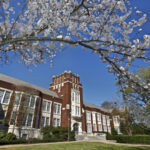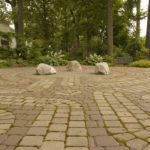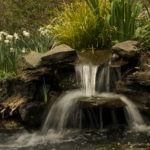Healing Therapeutic Garden at Kernan Hospital
Forging new pathways after life-changing illnesses and accidents
The Neuro-Rehabilitation Unit at Baltimore’s Kernan Hospital reminds us that life can change in an instant. Patients arrive at Kernan after devastating accidents or illnesses have permanently altered their lives. At Kernan, they must relearn basic functions like walking and talking and learn to live a new life that’s often nothing like the one they had before. As a recreational therapist, Patient Therapy Manager Linda Hutchinson-Troyer experienced how a beautiful environment can expedite patients’ recovery. And Kernan administration listened to her impassioned call to create a healing therapeutic garden.
Her own roots in gardening went way back to the huge garden her parents had when she was a child. As an adult she found gardening to be very therapeutic herself. She was the perfect Firesoul to make this garden happen.

A learning process for all involved
It quickly became a community effort to raise funds for the project and gather helping hands to make it happen. She reached out to potential donors and researched grants. The local garden club, Boy Scouts and former patients got involved. In fact, the Ten Hills Garden Club had just begun working with TKF to create a butterfly garden. So that’s where the Healing Therapeutic Garden at Kernan started. And it took flight from there.

Digging in
More hospital ground space could be put to use. So Linda wanted to expand beyond the butterfly garden to enhance the rehabilitation experience at Kernan. She really started digging in. She knew how important a healthy mind-body connection was to recovery. She read more about healing gardens and talked to professionals about what such gardens would look like. She approached TKF again about expanding, secured challenge grants from community groups and found a landscape architecture firm to design what she and the garden club envisioned.

Nature heals and helps patients deal
Linda recalled a study comparing two groups of hospital patients. They both had similar health issues and procedures done. But one group looked out their hospital windows at a brick wall, while the other looked at trees. The people who looked at trees used less pain medication, felt less stress and had lower blood pressure. TKF was aware of similar research <cite study or hyperlink to research on website?> that found hospital patients exposed to nature views healed faster than those who viewed brick walls.
This didn’t surprise Linda. It confirmed her own experiences with gardening and patients who spent time outdoors. Dealing with pain management is a big part of recovering. And therapists know if they can get patients involved in something they like in a pleasing environment, they often forget their pain. Linda knew a healing garden would provide Kernan’s patients with beautiful surroundings to lift their moods and use the tools they needed to help them rehabilitate.
Today I wheeled my wheelchair across the stone dust path. Someday I hope to walk across it.
– Anonymous Journal Entry
She knew families would use the garden, as they’re under a lot of stress. Hospital staff would, too. Once the garden was completed, the entries from the journals under the benches confirmed this.

Form follows function
Creating a garden like this required meeting special design considerations. Built into the beauty are rehabilitation tools designed to bring people back to their lives. Serious illnesses and accidents cause different kinds of impairments. A healing garden is composed of many elements—such as surfaces and textures, colors and scents, sounds and site lines—to accommodate different senses and abilities.
When patients leave Kernan, they’ll need to know how to navigate surfaces other than linoleum floors. So the garden includes textures and terrain they’ll encounter at home, such as grass, pavers, cement, ramps, steps and stone paths.
For the wheelchair bound, the garden is a training course. For example, the lily pond and bridge add beauty but also a therapeutic experience. The bridge has an incline for patients to work on propulsion. It’s harder to propel a wheelchair over stone than a smooth surface, so stone paths are designed to build strength, as is the incline returning from the butterfly garden.

The beds are filled with plants and flowers that provide colors and textures year round. In the summer, a trellis is covered with bright magenta clematis vine flowers. A variety of tree bark provides color and texture during winter.
Again, each element has a rehabilitative purpose. The garden incorporates wheelchair-height garden beds with two levels, so all patients can enjoy the plantings and work with adaptive gardening tools. The vine-covered trellis provides shade in the summer, which is important for patients with spinal cord injuries who have trouble regulating body temperature.
There are cognitive deficits with strokes and brain injuries. So therapists ask patients to identify things to see if they can follow directions. Engaging all senses enhances the learning experience. A therapist might direct, “Find me something that’s yellow.” Or ask, “Which flower smells sweet?”
Inspiring lifelong healing
Every aspect of the Healing Therapeutic Garden at Kernan—from flowerbed heights, to plant colors and scents, to pathway angles and materials—was planned to support patients’ recovery. While here, patients can find enjoy its beauty while practicing the skills they’ll need when they leave the hospital.





